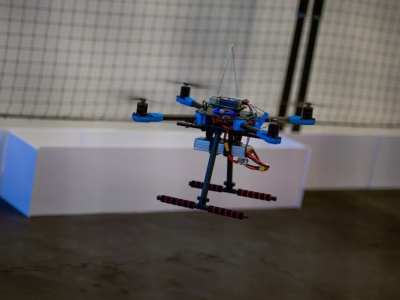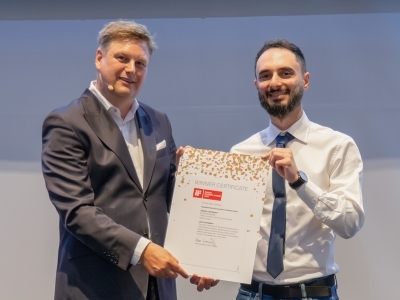 The Carleton Co-op Advantage
The Carleton Co-op Advantage
A co-op work term is often the first chance for students to take a test drive of potential career paths open to them after graduation. Luckily, the immersive experience is more than just a spin around the block. Carleton’s Co-op Program clears a path for students to achieve goals like obtaining valuable work experience, network-building, and earning money to offset the cost of tuition. Not only is co-op a fantastic opportunity for students, but for the university and its industry employers as well. Co-op students, as representatives of Carleton University, make great connections across the city and beyond, while employers gain fresh perspectives and valuable insight from an untapped, energetic crop of students with current skills and knowledge from their academic program. Carleton University’s Co-op Program has been supporting students, employers and organizations for over 25 years. With longer, flexible work terms, Carleton’s co-ops allow employers to gain a higher level of productivity from participating students, while giving students an opportunity to settle in to the workforce and, over time, contribute meaningfully and substantially to their team. Students must achieve and maintain a high academic average in order to participate in the program, which means employers have access to some of the highest performing students the university can offer.
The BIT Program
With a blend of both theoretical knowledge and practical hands-on experience, students within the Bachelor of Information Technology (BIT) are well-equipped to address the IT issues of today, while exploring and contributing to the future of the sector. The four distinct BIT programs: Information Resource Management (IRM), Interactive Multimedia and Design (IMD), Network Technology (NET) and Photonics and Laser Technology (PLT) are offered jointly by Carleton’s School of Information Technology and Algonquin College. All streams within BIT offer students the option to pursue co-op work terms, and students from these fields are some of the most highly sought after by industry. At their respective locations, BIT students are able to work for up to 12 months at a time, depending on the time of year and where they fall within the trajectory of their studies. While the recently established IRM program does not have any students participating in co-op yet, all four streams within BIT offer students the option to pursue co-op. And employers are quick to snap them up.
BIT Co-op Students in Action
Shannon Caissie (IMD program, 3rd Year, Communications Assistant, Department of Justice):

Shannon Caissie’s role with the communications team at the Department of Justice is an ever-evolving torrent of opportunity, including career-building experience filming videos of Deputy Minister Nathalie G. Drouin. She also met the Minister of Justice and Attorney General of Canada, Jody Wilson-Raybould, when providing photography and live streaming support for both a Ministerial meeting and an event on Parliament Hill. In fact, the Minister took a keen interest in hearing Caissie speak of her program at Carleton. Throughout the halls of the Justice building on Sparks Street are examples of Shannon’s recent graphic work on digital display screens and informational posters.
Caissie says her day-to-day tasks are fun, and variety keep things interesting. Recently, Caissie was given a Department of Justice Instant Award for her contribution to the communications branch. Her dedication and work ethic, it would seem, do not go unnoticed.
“I’m really quite honoured by the recognition that Justice has given me,” says Caissie. “One of the most beneficial things about co-op has been the opportunity to build my network. This experience is helping me decide where I want to work when I finish my studies, and it’s allowing me to meet the right people that can help me get there.”
“While co-op students are here we try to give them the opportunity to work with as many communications teams as possible to understand the diversity of our work – from employee engagement, to social media, to media relations and strategic communications, there is a lot to learn about,” says Chantal MacDonald, Acting Manager of Employee Engagement, and one of Caissie’s supervisors.
There are increasing demands in the workforce for people with Caissie’s skill set.
“The IMD program offers its students the tools and skills to work in creative and technological careers. I consider myself to be more of a designer than a programmer, so I have found that my creative courses have been beneficial to me, especially for this position at Justice,” says Caissie. “In my studies, I’ve learned practical skills in videography, photography, post-production for photos and video, special effects, design theories, graphic design, and illustration- just to name a few. All of these skills that I’ve developed in my courses have helped me excel in my current position.”
Caissie’s supervisors are quick to point out that not everyone working at the Department of Justice is a lawyer.
“The Government of Canada’s communications style is changing – people want to see and read information that is visually appealing, and mirrors the way in which they consume information digitally,” says Jennifer Reaney, Acting Manager of Corporate Communications. “The BIT-IMD program brings us co-op students with fantastic technical and creative expertise to our workplace. Along with these skills we are always looking for innovative people who are eager to learn and who can think strategically. The Public Service is a great place to build a career, it will challenge you and open your eyes to a wide variety of work on subjects that are important to Canadians.”

Shannon with one of her supervisors, Chantal MacDonald, in the departmental library
Samuel Robillard (NET program, 3rd year, Student Cloud Infrastructure Engineering at CENGN):

CENGN (Centre of Excellence in Next Generation Networks) works with small and medium-sized businesses, multinationals, the government, and academia to strengthen Canada’s leadership in Next Generation Networking. Driven to create an ecosystem that accelerates the growth of the Canadian Information and Communications Technology sector, this dynamic environment acts as a consortium for member organizations including Bell, Cisco, Nokia and many more. For Samuel Robillard, this co-op position could very well be a foot in the door at some of the top employers in his field.
“I’ve been given the opportunity to make a lot of professional connections across the IT sector, as CENGN has many industry members. They also host meetups and I’ve attended conferences,” says Robillard.
He’s also getting a leg up on new material not covered in his Carleton courses. “I get to work with innovative technologies that aren’t taught in school, such as OpenStack and Kubernetes, which are gaining a lot of popularity in the industry. I have been fortunate that the projects I work on are also Open Source, allowing me to connect with the communities,” he says.
Robillard acknowledges that without the preparation, knowledge, and skills acquired in Carleton’s NET program, he wouldn’t have the same level of success at CENGN.
“By having courses that cover networking, Linux systems, and programming, I have gained the skills needed to minimize the learning curve associated with next generation networking,” he says. “No matter how innovative networks get, they are still built on top of the same foundation. Having a solid understanding of these various aspects of IT has given me the chance to hit the ground running at CENGN and take on bigger projects than I would have without this knowledge.”
CENGN leverages co-op students like Robillard to evaluate the maturity of early open source technologies and solutions in the domains of cloud computing, software defined networks, wireless networking, the internet of things and cyber security.
“The assessment work done by the students accelerates the decision process associated with new solutions in a very dynamic world, keeping CENGN on the leading edge of technology,” says Boris Mimeur, Director of Engineering Operations with CENGN.
The CENGN team also views hiring co-op students as an opportunity to influence and train the next generation of the workforce. Hot on the heels of the next technological revolution, new technologies will reshape what is possible across all sectors including e-Health, precision agriculture, Smart Cities, and autonomous/connected cars. In order to continue Canada’s leadership in the realm of next generation networking, CENGN relies on the graduates of today to become the innovators of tomorrow.
“It is our mission to ensure the workforce of tomorrow are enabled and well-equipped to contribute and innovate in this new and exciting area,” says Randy Elias, CENGN Program Manager. “We have found Sam to be an exceptional student that combines both his academic learnings and personal interests in technology to provide significant contributions to CENGN’s engineering team. He has demonstrated his ability to adapt to new complex technologies and provide a tangible outcome CENGN can use long after his term. In addition, his passion for next generation technologies and tools has set him apart,” he says.

Samuel Robillard with his supervisors, CENGN Program Manager Randy Elias and Director of Engineering and Operations Boris Mimeur
Eric Arezza (PLT Program, 3rd year, Research Student at Gastops)

Gastops has built their business on innovative contributions to the maintenance, productivity, and safety of critical equipment used in aviation, energy, marine, rail, and mining industries. The company tagline – ‘Long Live Equipment’ – reflects Gastops’ commitment to high standards of safety, reliability, availability and cost-effective operations for advanced equipment sensing and analysis products.
Working alongside Gastops’ chief laser scientist, co-op student Eric Arezza has familiarized himself with LIBS (Laser-Induced Breakdown Spectroscopy) technology, and even set up and aligned a LIBS platform on his own. This was a major confidence boost, he says.
“Working in R&D at Gastops is fun and interesting because there is a constant push for improvement. Getting results from each experiment is motivating, and determines our next direction,” says Arezza.
Essentially, the Gastops product Arezza has been working on enables fast and reliable on-site detection of metal debris in the lubricating fluid of mechanical systems for maintenance purposes. He runs the experiments, collects and records data, and prepares technical reports on the results of the experiments in order to advance the product line to the next generation.
“His contributions have been instrumental in allowing us to run multiple investigations in parallel so as to meet our accelerated schedule,” says Pooja Suresh, Research Manager with Gastops. “The work he recently completed will soon be transitioned into product development, and will be incorporated into the next product release for significant performance improvements. This is a great example of co-op student contributions at Gastops that have resulted in tangible outcomes.”
Eric is also researching and reviewing advanced technologies that Gastops hopes to experimentally investigate in the near future.
“He has presented his findings to the team and facilitated brainstorming discussions, enabling us to plan future work. His education has helped him learn the ropes very quickly at the job. His photonics fundamentals and lab training in the use of lasers and optics have held him in good stead,” says Suresh.
Without the PLT program at Carleton, Arezza says he would be less equipped to effectively work in R&D.
“The program introduced me to some businesses and organizations in the photonics community which can be helpful when trying to resource parts, equipment, or information. I probably would not have known about some local and international businesses, the industry, and organizations such as SPIE or even Photonics North conferences had I not been in the PLT program. The awareness of the photonics community has certainly been beneficial.”
At Gastops, his hands-on experience assembling photonics systems and understanding how to configure them to perform is coupled with new knowledge of different industrial metals, oil chemistry, and data processing.
“Other valuable experience I’m gaining is recognizing how projects are managed, the importance of regular communication, and the general logistics of product development,” says Arezza. He also notes that this work experience is helping him progress towards his intended career path, and is grateful to be working in an environment that offers both technical knowledge and career development opportunities.
For some, a co-op term at Gastop lands them a job.
“The co-op program is a very effective recruiting tool for us,” says Suresh. “Over the years, we have hired many students who have been an integral part of our team, and many have transitioned to permanent positions after graduation- including myself.”

Eric Arezza with his supervisor, Gastops Research Manager Pooja Suresh
Interested in hiring Carleton students for co-op? Contact Corporate Relations Officer Robin McLaughlin at robin.mclaughlin@carleton.ca.



